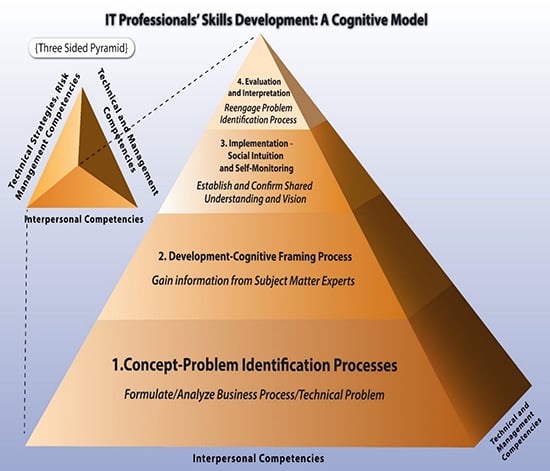Developing and Improving Student Non-Technical Skills in IT Education: A Literature Review and Model
Abstract
:1. Introduction
Purpose Statement
2. Materials and Methods
3. The Development of Non-Technical Skills
3.1. Non-Technical Factors Necessary for IT Success
3.2. An Explanation of Non-Technical Factors
3.3. Critical Success Factors in IT: A Project-Individual Perspective
4. Project Simulation: A Model for Teaching
- Conceptualization, (Concept-Problem Identification Process): In this step, in addition to the generally-accepted steps of problem identification, students will also be expected to display those non-technical skills necessary to successfully complete the process.
- Software or system development (Development-Cognitive Framing Process): In this step, in addition to general software or systems development, students will also be expected to display those non-technical skills related to cognitive reframing (as seen in Table 1).
- Implementation (Implementation-Social Intuition-Self-Monitoring Process): In this step, in addition to the generally-accepted technical process of software or systems implementation, students will also be expected to display those non-technical skills related to social and self-influences that help to establish and confirm shared understanding and shared vision for an IT project.
- Evaluation (Evaluation and Interpretation): In this step, in addition to the generally-accepted technical process of project evaluation, students will also be expected to display those non-technical skills that will help to re-engage stakeholders in any additional problem identification processes necessary to bring the simulated IT project to successful completion.
4.1. Integration of Non-Technical-Skills into Core IT Curriculum: An Algorithmic Approach
4.2. Collaborative Problem Identification
4.3. The Importance of Cognitive Frameworks
4.4. Social Intuition and Contextual Awareness as a Function of Self-Monitoring
The technical project requirements and corresponding non-technical skill requirements were established through a review of the areas listed in column 1 of Table 2; a thoughtful review of the themes derived in the initial literature search revealed key areas of interest for each of the simulated project steps.
4.5. Non-Technical Skills as a Function of Project Processes
5. Implications and Conclusions
Acknowledgments
Author Contributions
Conflicts of Interest
References
- Wilder Foundation. Information Technology Industry Sector Preliminary Themes; Unpublished typescript; Wilder Foundation: St. Paul, MN, USA, 2012. [Google Scholar]
- Meeting Minnesota’s Workforce Needs; Minnesota State Colleges and Universities: St Paul, MN, USA, 2012; Available online: http://www.mnscu.edu/business/workforceassessment/doc/IT%20Workforce%20Summary-09%202012.pdf (accessed on 15 June 2016).
- Andrews, J.; Higson, H. Graduate employability, ‘soft skills’ versus ‘hard’ business knowledge: A European study. High. Educ. Eur. 2008, 33, 411–422. [Google Scholar] [CrossRef]
- Bassellier, G.; Benbasat, I. Business competence of information technology professionals: Conceptual development and influence on IT-business partnerships. MIS Q. 2004, 28, 673–694. [Google Scholar]
- Zhang, L.; Jones, M. Can social capital enhance the careers of IT professionals? Inf. Resour. Manag. J. 2009, 22, 69–82. [Google Scholar] [CrossRef]
- Shields, K.; Johnson, J.A. Report of the Rhode Island Information Technology Skills Gap Task Force; Rhode Island Governors’ Workforce Board: Cranston, RI, USA, 2008. [Google Scholar]
- Kasper, G. Information technology and individualized mass higher education. Inf. Resour. Manag. J. 1996, 9, 3–4. [Google Scholar]
- Aasheim, C.L.; Li, L.; Williams, S. Knowledge and skill requirements for entry-level information technology workers: A comparison of industry and academia. J. Inf. Syst. Educ. 2009, 20, 349. [Google Scholar]
- Beard, D.; Schwieger, D.; Surendran, K. Integrating soft skills assessment through university, college, and programmatic efforts at an AACSB accredited institution. J. Inf. Syst. Educ. 2008, 19, 229–240. [Google Scholar]
- Cox, S.; King, D. Skill sets: An approach to embed employability in course design. Educ. Train. 2006, 48, 262–274. [Google Scholar] [CrossRef]
- Blumenberg, S.; Beimborn, D.; Koenig, W. Determinants of IT outsourcing relationships: A conceptual model. In Proceedings of the 41st Annual Hawaii International Conference on System Sciences, Waikoloa, HI, USA, 7–10 January 2008.
- Brody, R.; Bird, S.; Xin, R.L.; Seazzu, A. Social engineering: The neglected human factor for information security management. Inf. Resour. Manag. J. 2011, 24, 1–8. [Google Scholar]
- Marcello, C.V. A Correlational Analysis: Perceptions of Workplace Bullying and Psychological Empowerment among IT Professionals. Ph.D. Thesis, University of Phoenix, Tempe, AZ, USA, 2010. [Google Scholar]
- Bloomfield, B.P.; Danieli, A. The role of management consultants in the development of information technology: The indissoluble nature of socio-political and technical skills. J. Manag. Stud. 1995, 32, 23–46. [Google Scholar] [CrossRef]
- Torraco, R.J. Writing integrative literature reviews: Guidelines and examples. Hum. Resour. Dev. Rev. 2005, 4, 356–367. [Google Scholar] [CrossRef]
- Richards, L. Handling Qualitative Data: A Practical Guide; Sage: Thousand Oaks, CA, USA, 2014. [Google Scholar]
- Robles, M. Executive perceptions of the top 10 soft skills needed in today’s workplace. Bus. Commun. Q. 2012, 4, 453–465. [Google Scholar] [CrossRef]
- Nealy, C. Integrating soft skills through active learning in the management classroom. J. Coll. Teach. Learn. 2005, 2. [Google Scholar] [CrossRef]
- Xu, F. The Priority of Listening Comprehension over Speaking in the Language Acquisition Process. Int. Educ. Stud. 2011, 4, 161–165. [Google Scholar] [CrossRef]
- Kreps, G.L. Relational communication in health care. South. Speech Commun. J. 1988, 53, 344–359. [Google Scholar] [CrossRef]
- Barratt, M. Understanding the meaning of collaboration in the supply chain. Supply Chain Manag. 2004, 9, 30–42. [Google Scholar] [CrossRef]
- Stank, T.; Crum, M.; Arango, M. Benefits of interfirm coordination in food industry supply chains. J. Bus. Logist. 1999, 20, 21–41. [Google Scholar]
- Baker, D.; Georgakopoulos, D.; Schuster, H.; Cassandra, A.; Cichocki, A. Providing customized process and situation awareness in the collaboration management infrastructure. In Proceedings of the 1999 IFCIS International Conference on Cooperative Information Systems, Edinburgh, Scotland, 2–4 September 1999; pp. 79–91.
- Fulk, J. Social construction of communication technology. Acad. Manag. J. 1993, 36, 921–950. [Google Scholar] [CrossRef]
- Ryhammar, L.; Brolin, C. Creativity research: Historical considerations and main lines of development. Scand. J. Educ. Res. 1999, 43, 259–273. [Google Scholar] [CrossRef]
- Norris, S.P. Synthesis of research on critical thinking. Educ. Leadersh. 1985, 42, 40–45. [Google Scholar]
- Hall, E.T. Beyond Culture; Anchor Books: New York, NY, USA, 1976. [Google Scholar]
- Hofstede, G. National cultures in four dimensions: A research-based theory of cultural differences among nations. Int. Stud. Manag. Organ. 1983, 13, 46–74. [Google Scholar] [CrossRef]
- Victor, D.A. International Business Communication; Harper-Collins: New York, NY, USA, 1994. [Google Scholar]
- Kinicki, A.; Kreitner, R. Organizational Behavior: Key Concepts, Skills & Best Practices; McGraw-Hill/Irwin: Tallahases, FL, USA, 2003. [Google Scholar]
- Gardenswartz, L.; Rowe, A. The Managing Diversity Survival Guide: A Complete Collection of Checklists, Activities, and Tips; McGraw-Hill: Tallahases, FL, USA, 1994. [Google Scholar]
- Lewis, P.V. Defining ‘business ethics’: Like nailing jello to a wall. J. Bus. Ethics 1985, 4, 377–383. [Google Scholar] [CrossRef]
- Rockart, J.F. The changing role of the information systems executive: A critical success factor perspective. Sloan Manag. Rev. 1982, 24, 3–13. [Google Scholar]
- Cropanzano, R.; Mitchell, M.S. Social Exchange Theory: An Interdisciplinary Review. J. Manag. 2005, 31, 874–900. [Google Scholar] [CrossRef]
- D’Zurilla, T.J.; Nezu, A.M. Problem-Solving Therapy. Handbook of Cognitive-Behavioral Therapies; The Guilford Press: New York, NY, USA, 2010; pp. 197–225. [Google Scholar]
- VanZandt, C.E. Professionalism: A matter of personal initiative. J. Couns. Dev. 1990, 68, 243–245. [Google Scholar] [CrossRef]
- Bolman, L.G.; Deal, T.E. Reframing Organizations: Artistry, Choice, and Leadership; Jossey-Bass: San Francisco, CA, USA, 2007. [Google Scholar]
- Russo, J.E.; Schoemaker, P.J.H. Winning Decisions; Random House: New York, NY, USA, 2002. [Google Scholar]
- Brent, R.; Anderson, P. Developing children’s classroom listening strategies. Read. Teach. 1993, 47, 122–126. [Google Scholar]
- Jalongo, M.R. Promoting active listening in the classroom. Child. Educ. 1995, 72, 13–18. [Google Scholar] [CrossRef]
- Cavalier, J.C.; Klein, J.D.; Cavalier, F.J. Effects of cooperative learning on performance, attitude, and group behaviors in a technical team environment. Educ. Technol. Res. Dev. 1995, 43, 61–72. [Google Scholar] [CrossRef]
- Kim, Y.; Addom, B.K.; Stanton, J.M. Education for eScience professionals: Integrating data curation and cyberinfrastructure. Int. J. Digit. Curation 2011, 6, 125–138. [Google Scholar] [CrossRef]
- Archibugi, D.; Iammarino, S. The globalization of technological innovation: Definition and evidence. Rev. Int. Polit. Econ. 2002, 9, 98–122. [Google Scholar] [CrossRef]
- Malhotra, A.; Majchrzak, A.; Carman, R.; Lott, V. Radical innovation without collaboration: A case study at Boeing-Rocketdyne. MIS Q. 2001, 25, 229–249. [Google Scholar] [CrossRef]
- Cooper, R.B. Information technology development creativity: A case study of attempted radical change. MIS Q. 2000, 24, 245–276. [Google Scholar] [CrossRef]
- Michalko, M. Thinkertoys: A Handbook of Creative-Thinking Techniques; Ten Speed Press: Berkeley, CA, USA, 2010. [Google Scholar]
- Du Plessis, M. The role of knowledge management in innovation. J. Knowl. Manag. 2007, 11, 20–29. [Google Scholar] [CrossRef]
- Dahl, D.W.; Moreau, P. The influence and value of analogical thinking during new product ideation. J. Mark. Res. 2002, 39, 47–60. [Google Scholar] [CrossRef]
- Ames, M.; Runco, M.A. Predicting entrepreneurship from ideation and divergent thinking. Creativity Innov. Manag. 2005, 14, 311–315. [Google Scholar] [CrossRef]
- Ennis, R.H. A logical basis for measuring critical thinking skills. Educ. Leadersh. 1985, 43, 44–48. [Google Scholar]
- Ivanov, K. Critical systems thinking and information technology: Some summary reflections, doubts, and hopes through critical thinking critically considered, and through hypersystems. J. Appl. Syst. Anal. 1991, 18, 39–55. [Google Scholar]
- Bruce, C.S. Workplace experiences of information literacy. Int. J. Inf. Manag. 1999, 19, 33–48. [Google Scholar] [CrossRef]
- Shachaf, P. Cultural diversity and information and communication technology impacts on global virtual teams: An exploratory study. Inf. Manag. 2008, 45, 131–142. [Google Scholar] [CrossRef]
- Gaul, S.; Wilkowska, W.; Ziefle, M. Accounting for user diversity in the acceptance of medical assistive technologies. In Proceedings of the 3rd International ICST Conference on Electronic Healthcare for the 21st Century, Casablanca, Morocco, 13–15 December 2010.
- Dunaway, M.M. IS Learning: The Impact of Gender and Team Emotional Intelligence. J. Inf. Syst. Educ. 2013, 24, 189–202. [Google Scholar]
- Weigelt, C.; Sarkar, M. Learning from supply-side agents: The impact of technology solution providers’ experiential diversity on clients’ innovation adoption. Acad. Manag. J. 2009, 52, 37–60. [Google Scholar] [CrossRef]
- Longstaff, T.A.; Chittister, C.; Pethia, R.; Haimes, Y. Are we forgetting the risks of information technology? Computer 2000, 33, 43–51. [Google Scholar] [CrossRef]
- Collins, N.L.; Read, S. Adult attachment, working models, and relationship quality in dating couples. J. Personal. Soc. Psychol. 1990, 58, 644–663. [Google Scholar] [CrossRef]
- Junnarkar, B.; Brown, C.V. Re-assessing the enabling role of information technology in KM. J. Knowl. Manag. 1997, 1, 142–148. [Google Scholar] [CrossRef]
- Ley, T.; Seelmeyer, U. Profesionalism and Information Technolgy: Positining and mediation. Soc. Work Soci. Int. Online J. 2008, 6, 338–351. [Google Scholar]
- Ariyachandra, T.R.; Frolick, M.N. Critical success factors in business performance management—Striving for success. Inf. Syst. Manag. 2008, 25, 113–120. [Google Scholar] [CrossRef]
- Lawson-Body, A.; Willoughby, L.; Mukankusi, L.; Logossah, K. The critical success factors for public sector CRM implementation. J. Comput. Inf. Syst. 2011, 52, 42–54. [Google Scholar]
- Biehl, M. Success factors for implementing global information systems. Commun. ACM 2007, 50, 52–58. [Google Scholar] [CrossRef]
- Wong, K.Y. Critical success factors for implementing knowledge management in small and medium enterprises. Ind. Manag. Data Syst. 2005, 105, 261–279. [Google Scholar] [CrossRef]
- Poon, P.P.; Wagner, C. Critical success factors revisited: Success and failure cases of information systems for senior executives. Decis. Support Syst. 2001, 30, 393–418. [Google Scholar] [CrossRef]
- Sommers, T.M.; Nelson, K. The impact of critical success fators acorss stages of enterprise resource planning systems. In Proceedings of the 34th Annual Hawaii International Conference on Systems Sciences, Maui, HI, USA, 6 January 2001.
- Nah, F.F.H.; Lau, J.L.S.; Kuang, J. Critical factors for successful implementation of enterprise systems. Bus. Process Manag. J. 2001, 7, 285–296. [Google Scholar]
- Frolick, M.N.; Ariyachandra, T.R. Business performance management: One truth. Inf. Syst. Manag. 2006, 23. [Google Scholar] [CrossRef]
- Lee, J.H.; Shim, H.J.; Kim, K.K. Critical success factors in SOA implementation: An exploratory study. Inf. Syst. Manag. 2010, 27, 123–145. [Google Scholar] [CrossRef]
- Chow, T.; Cao, D.B. A survey study of critical success factors in agile software projects. J. Syst. Softw. 2008, 81, 961–971. [Google Scholar] [CrossRef]
- Taylor, H.; Woelfer, J.P. Behavioral Competencies and Learning Methods for Information Technology Project Management: An Exploratory Study. In Proceedings of the 4th International Research Workshop on Information Technology Project Management, Phoenix, AZ, USA, 14 December 2009.
- Woodward, B.; Sendall, P.; Ceccucci, W. Integrating soft skill competencies through project-based learning across the information systems curriculum. Inf. Syst. Educ. J. 2010, 8, 1–15. [Google Scholar]
- Olson, J.R. The sky’s the limit: An activity for teaching project management. J. Manag. Educ. 2006, 30, 404–20. [Google Scholar]
- Loch, C.H.; De Meyer, A.; Pich, M.T. A Broader Look at Project Risk Management. In Managing the Unknown: A New Approach to Managing High Uncertainty and Risk in Projects; John Wiley & Sons, Inc.: Hoboken, NJ, USA, 2006. [Google Scholar]
- Deininger, M.; Schneider, K. Teaching software project management by simulation—Experiences with a comprehensive model. In Software Engineering Education; Springer Berlin: Heidelberg, Germany, 1994; pp. 227–242. [Google Scholar]
- Helle, L.; Tynjälä, P.; Olkinuora, E. Project-based learning in post-secondary education-theory, practice and rubber sling shots. High. Educ. 2006, 51, 287–314. [Google Scholar] [CrossRef]
- Eteläpelto, A. The Development of Expertise in Information Systems Design; University of Jyväskylä: Jyväskylä, Finland, 1998. [Google Scholar]
- Morgan, A. Theoretical Aspects of Project-Based Learning in Higher Education. Br. J. Educ. Technol. 1983, 14, 66–78. [Google Scholar] [CrossRef]
- Nunamaker, J.; Chen, M.; Purdin, T. Systems development in information systems research. J. Manag. Inf. Syst. 1990, 7, 89–106. [Google Scholar] [CrossRef]
- Dagdilelis, V.; Satratzemi, M.; Evangelidis, G. Introducing secondary education students to algorithms and programming. Educ. Inf. Technol. 2004, 9, 159–173. [Google Scholar] [CrossRef]
- Chaitin, G.J. Thoughts on the Riemann hypothesis. Math. Intell. 2004, 26, 4–7. [Google Scholar] [CrossRef]
- Ormrod, J. Human Learning; Pearson Prentice Hall: Upper Saddle River, NJ, USA, 2008. [Google Scholar]
- Frank, D.V.; Baker, C.A.; Heron, J.D. Should students always use algorithms to solve problems? In Proceedings of the 190th National Meeting of the American Chemical Society, Chicago, IL, USA, 8–13 September 1985.
- Lau, R.R.; Redlawsk, D. Advantages and disadvantages of cognitive heuristics in political decision making. Am. J. Polit. Sci. 2001, 45, 951–971. [Google Scholar] [CrossRef]
- Dillenbourg, P.; Traum, D. Sharing solutions: Persistence and grounding in multimodal collaborative problem solving. J. Learn. Sci. 2006, 15, 121–151. [Google Scholar] [CrossRef]
- Antunes, P.; Santos, R.; Videira, N. Participatory decision making for sustainable development—The use of mediated modelling techniques. Land Use Policy 2006, 23, 44–52. [Google Scholar] [CrossRef]
- Ribbers, P.M.A.; Peterson, R.R.; Parker, M.M. Designing information technology governance processes: Diagnosing contemporary practices and competing theories. In Proceedings of the 35th Annual Hawaii International Conference on System Sciences, Big Island, HI, USA, 7–10 January 2002; pp. 3143–3154.
- Anderson, C.R.; Paine, F.T. Managerial perceptions of strategic behavior. Acad. Manag. J. 1975, 18, 811–823. [Google Scholar] [CrossRef]
- Nonacs, P. Is satisficing an alternative to foraging theory? Oiko 1993, 67, 371–384. [Google Scholar] [CrossRef]
- Dutton, J.; Fahey, L.; Narayanan, V. Toward understanding strategic issue diagnosis. Strateg. Manag. J. 1983, 4, 307–323. [Google Scholar] [CrossRef]
- Davidson, R.J.; Begley, S. The Emotional Life of Your Brain; Hudson Street Press: New York, NY, USA, 2012. [Google Scholar]
- Lennox, R.D.; Wolfe, R.N. Revision of the self-monitoring scale. J. Personal. Soc. Psychol. 1984, 46, 1349–1364. [Google Scholar] [CrossRef]
- Leary, M.R.; Kowalski, R.M. Impression management: A literature review and two-component model. Psychol. Bull. 1990, 107, 34–47. [Google Scholar] [CrossRef]
- Day, D.V.; Schleicher, D.J.; Unckless, A.L.; Hiller, N.J. Self-monitoring personality at work: A meta-analytic investigation of construct validity. J. Appl. Psychol. 2002, 87, 390–401. [Google Scholar] [CrossRef] [PubMed]
- Dennett, D.C. The evolution of reasons. In Contemporary Philosophical Naturalism and Its Implications; Routledge: London, UK, 2013. [Google Scholar]
- Schwalbe, K. Information Technology Project Management; Cengage Learning: Hampshire, UK, 2015. [Google Scholar]
- Lieberman, H.; Paternò, F.; Wulf, V. End User Development; Springer: Doerdract, The Netherlands, 2006. [Google Scholar]
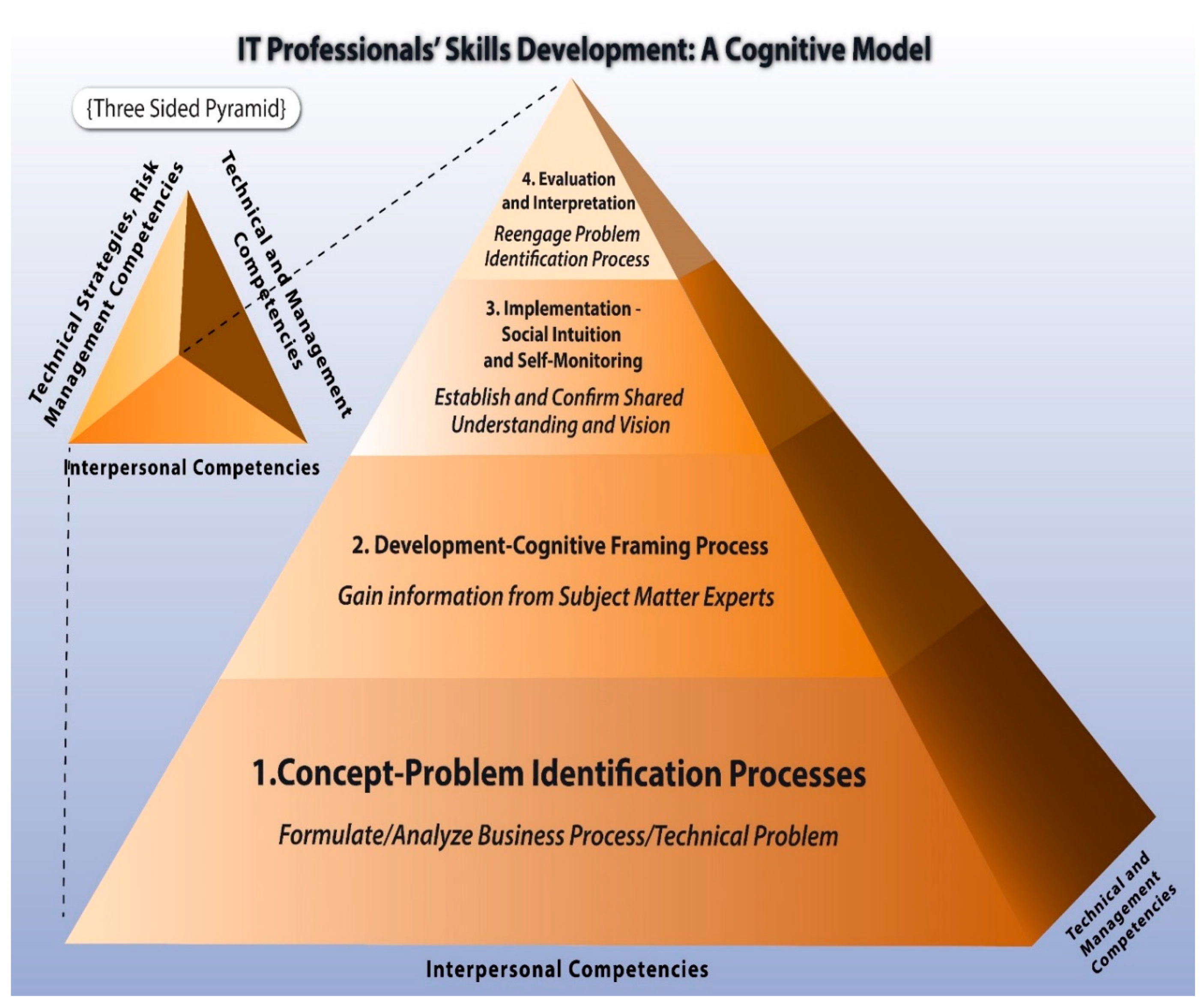
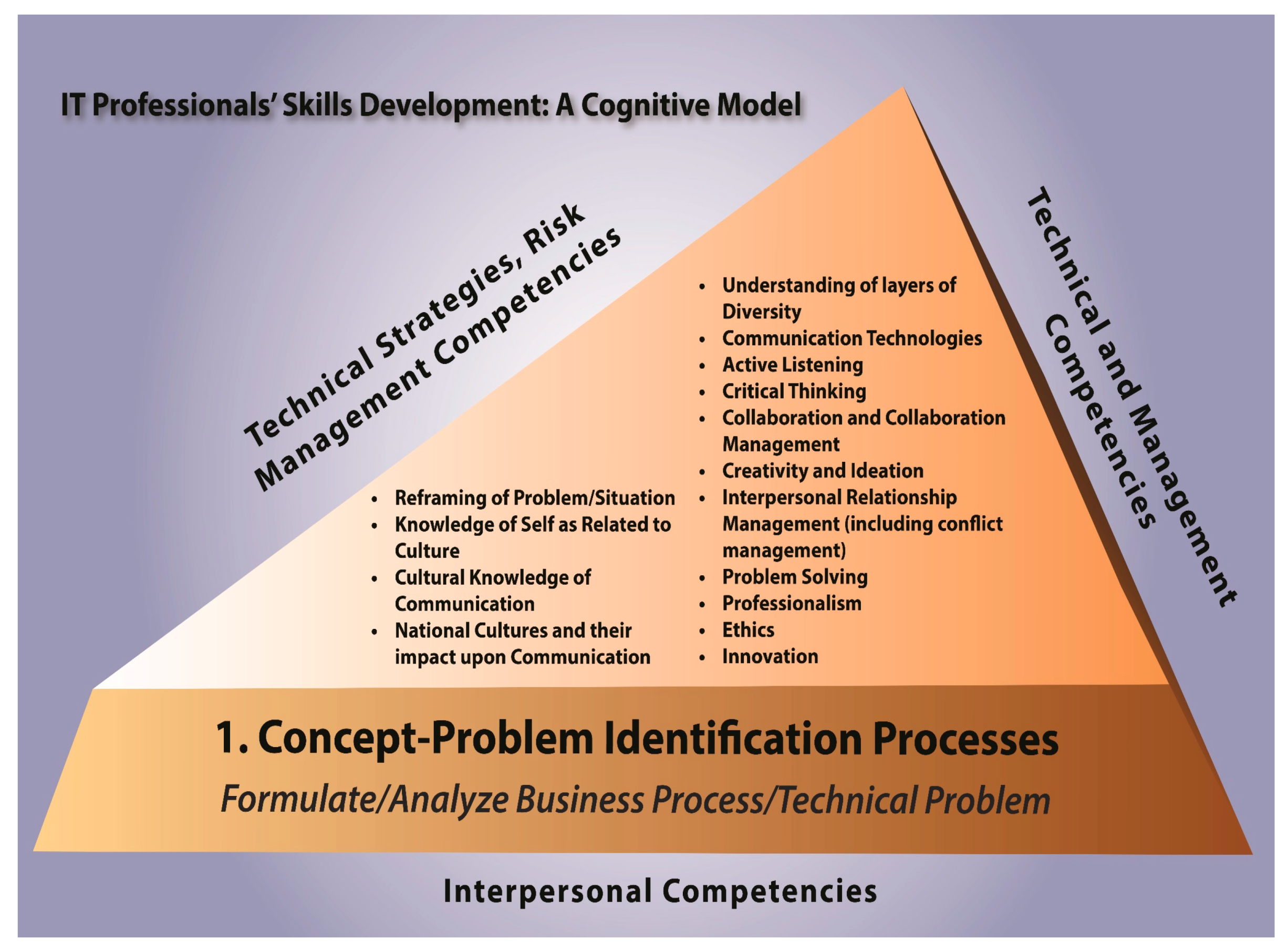
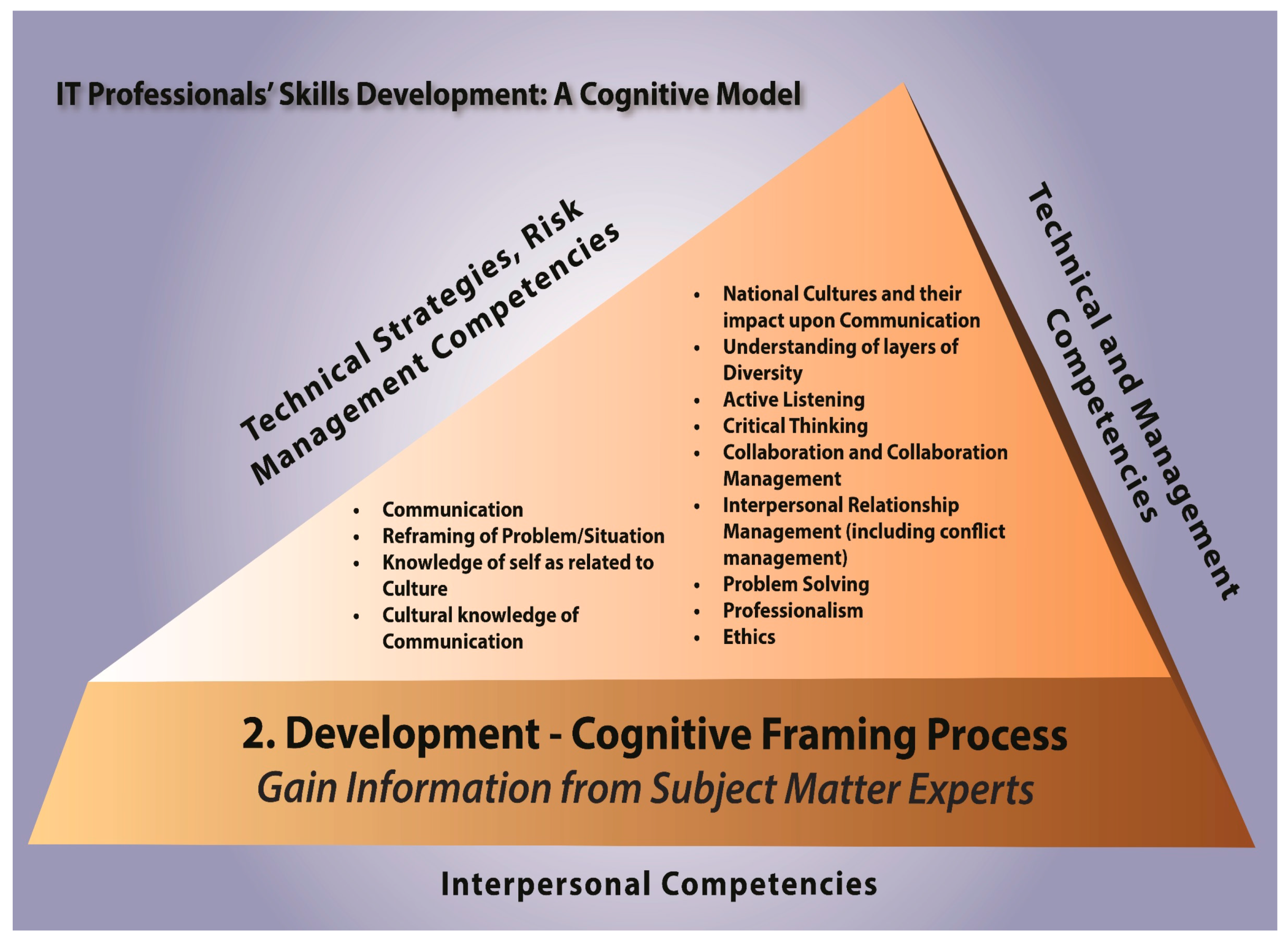
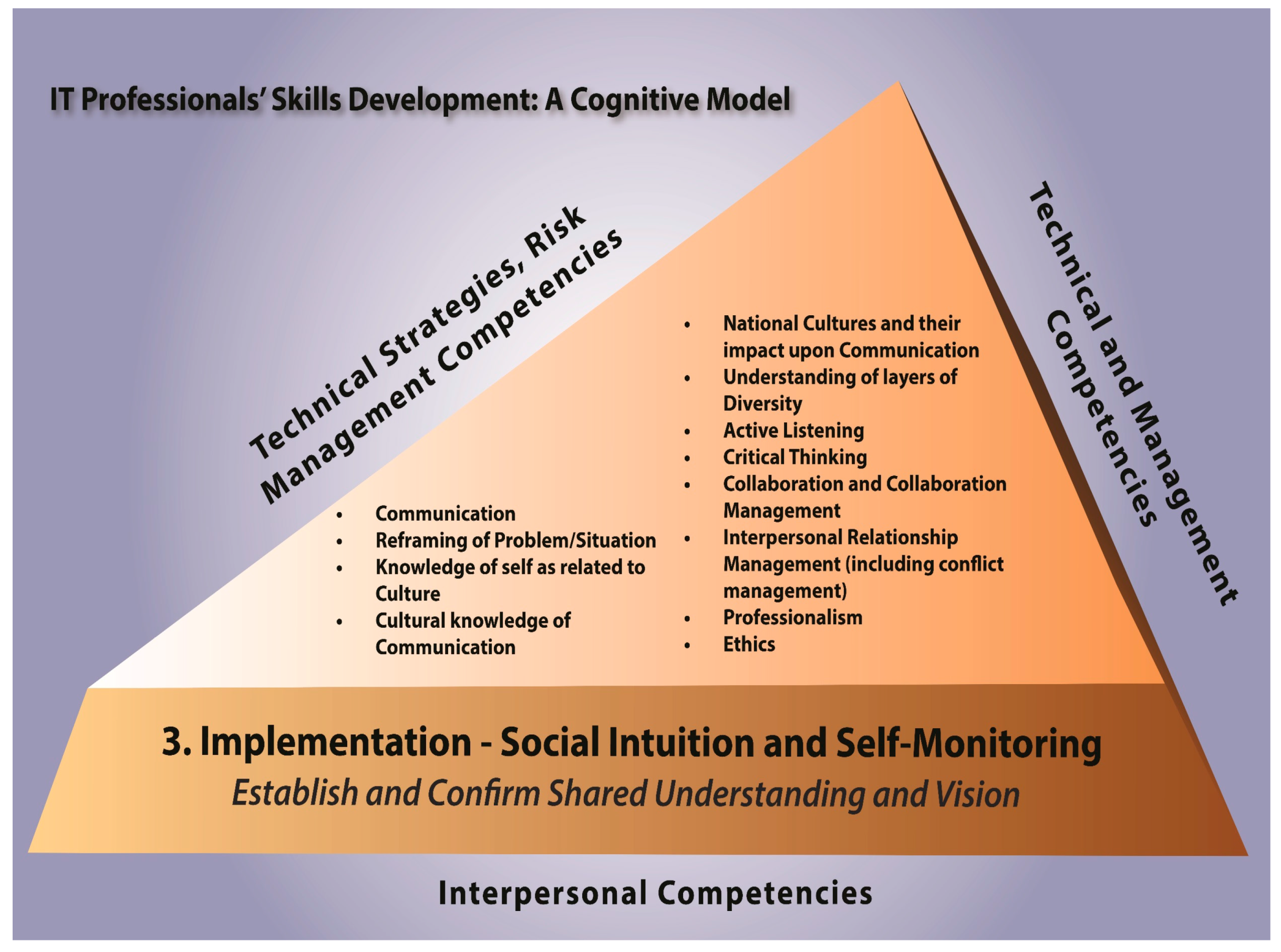
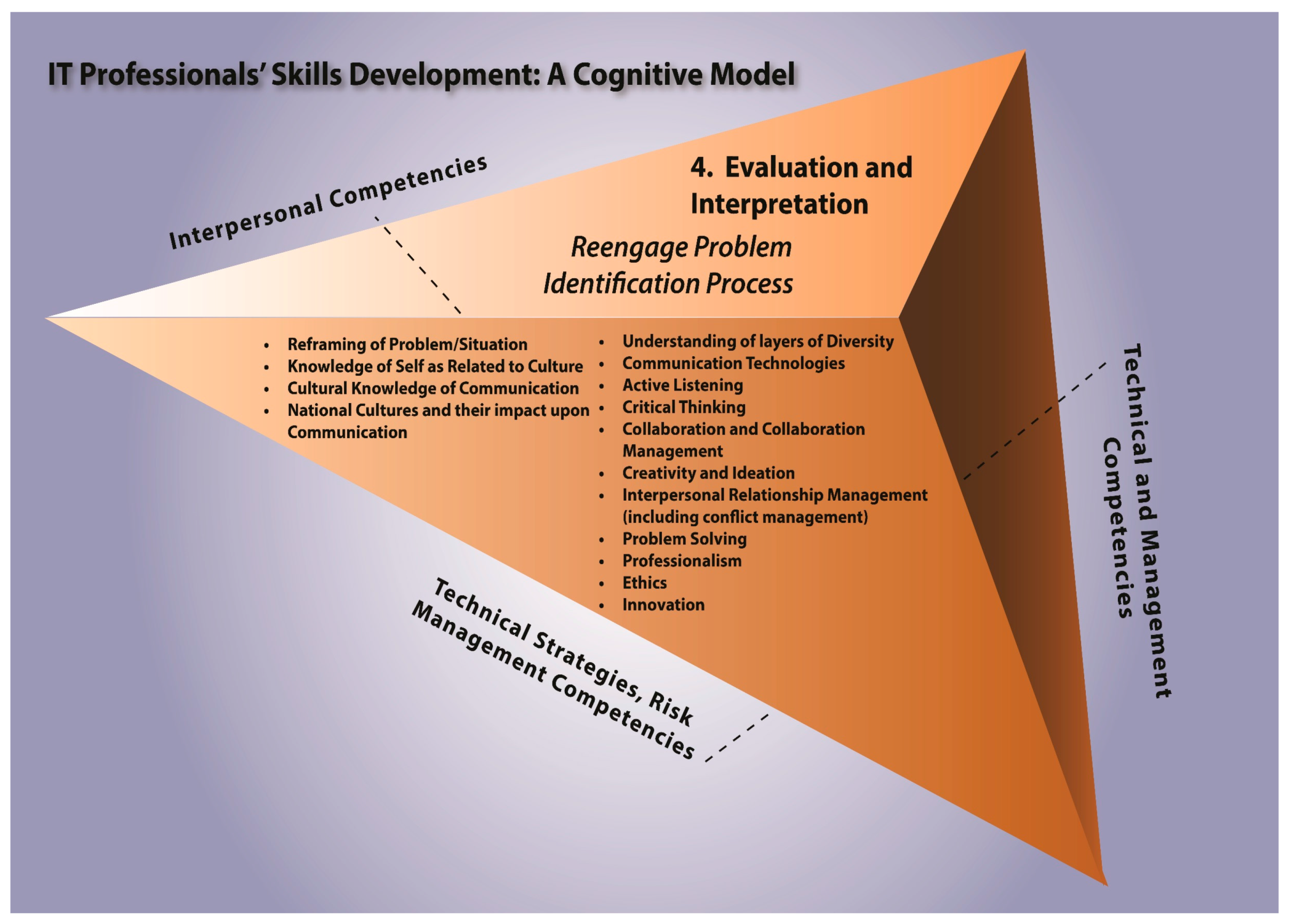
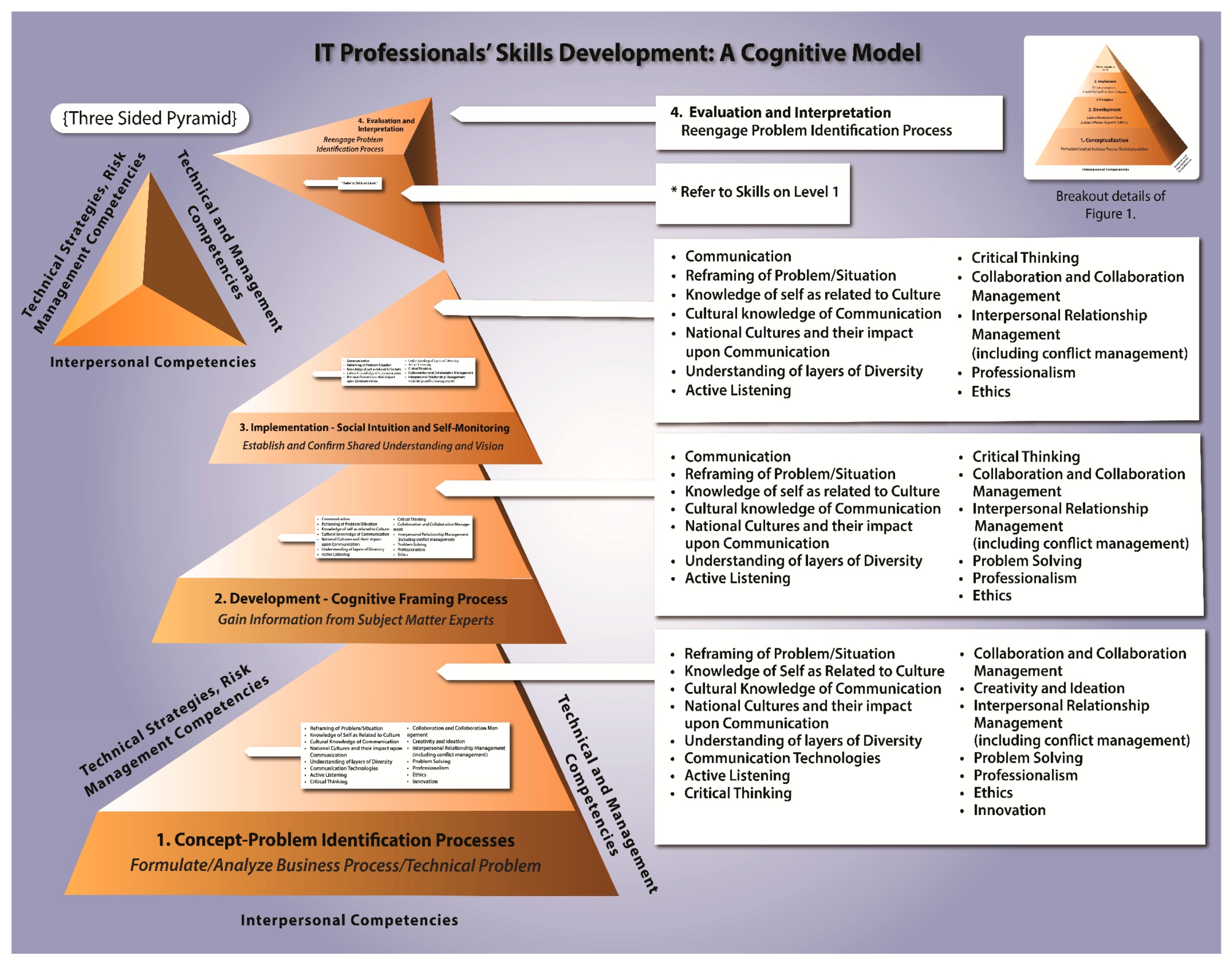
| 1. Active listening | Communication technique that involves conceptual understanding, feedback, and confirmation of decoding of a message(s) via cognitive interpretation processes [19]. This understanding must include processes on the part of all parties; contributes to the effectiveness of group communication and group functioning. |
| 2. Communication (general) | Appropriate exchange of thoughts, ideas (both verbal and visual), and messages for the purpose of exchange of key information related to organizational and situationally specific problems and perspectives [20] in an effort to solve key problems. |
| 3. Collaboration and collaboration management | Development and fostering of work-related relationships in which mutuality of benefit and risk-sharing take place within the context of information exchange [21,22]. Management of this collaboration involves the capturing and coordination of collaborative processes, often via technology [23]. |
| 4. Communication technologies | Understanding of, and skills related to, the use of new technologies and media for the purpose of communication of complex information to organization members. Is related to social constructs within organizations and the social exchanges that take place within those [24] in an effort to gather information, enhance learning and knowledge, and/or build consensus. |
| 5. Creativity and ideation | Within the context of creative problem solving, the process of assessing multiple cognitive domains for the purpose of creative idea development [25]. |
| 6. Critical thinking | Ability to test assumptions, make critical evaluations, and critically review systems and/or approaches [26]. |
| 7. Cultural knowledge of communication | Ability to communicate with audiences based upon understandings of communication patterns, processes, and expectations; knowledge of communication patterns exhibited by audiences, including issues of time, space, and contextual orientation [27] |
| 8. Cultural knowledge of self as related to culture | Ability to understand and interpret preconceptions, biases, or displays of incongruence as related to one’s culture and the culture (national or otherwise) of others. Culture in this case is defined as the totality of ones “words, actions, postures, gestures, tones of voice, facial expressions, the handling of time, space and materials…” all of which are based upon historical, social and cultural contexts, and drive ones behavior and the meanings behind communications [27]. |
| 9. Cultures and their impact upon communication; National cultures | Understanding of how national cultures can impact patterns of thinking, feeling and acting [28], including the ability to understand attitude toward specific communication channels and the ability to apply and react appropriately to these preferences [29]. |
| 10. Diversity knowledge (Understanding and Application) | An understanding of, and appreciation for, diversity in race, sex, ability, and/or perspective for the purpose of improving overall organizational outcomes. |
| 11. Diversity (layers of) | Knowledge and understanding of diversity from the perspective of the four-layer diversity model [30]; knowledge of definition of diversity, including personal, internal, external, and organizational dimensions [31]. |
| 12. Ethics | “Rules, standards, codes or principles which provide guidelines for morally right behavior and truthfulness in specific situations” [32]. |
| 13. Innovation | Creation or invention of novel, new or interesting processes, products, or technologies [33]. |
| 14. Interpersonal relationship management | Related to relationship quality; ability to develop and manage relationships (including conflict management). Involves transactions in social relationships between two interacting partners [34]. |
| 15. Primary and subcultures of audience (knowledge of) | Understanding what elicits an appropriate and/or expected response given the understanding of the subculture of the message give and/or receiver [27]. |
| 16. Problem solving | The rational, deliberate application of problem solving models in an effort to seek appropriate answers to problems [35]; the ability to integrate information from several different sources in order to improve organizational performance through the integration of multiple platforms, functions, and technologies. |
| 17. Professionalism | Conduct or qualities that promote value and respect for the profession and the individual representing that profession [36]. |
| 18. Re-framing of problems/situations: | Restructuring one’s mental models to better understand, interpret, and negotiate organizational problems and/or situations; understanding when to apply particular frames based upon a given situation, organizational culture, or particular point of view of other individuals who may be involved [37]. Or, the application of limited information to improve decision making processes through the application of appropriate decision making schemas and/or organizing systems for the purpose of the identification of key issues and possible solutions [38]. |
| Area | Critical Success Factors | Author | Non-Technical Skill-Individual Level |
|---|---|---|---|
| Organizational factors | Top management support | Ariyachandra and Frolic [61]; Lawson-Body, Willoughby, Mukankusi and Logossah [62]; Biehl [63]; Wong [64]; Poon and Wagner [65]; Sommers and Nelson [66]; Nah, Lau and Kuang [67] | Interpersonal relationship management; Reframing skills; Communication (general); Professionalism; Ethics |
| Project sponsorship /champion | Nah, Lau and Kuang [67]; Poon and Wagner [65]; Frolick and Ariychandra [68]; Sommers and Nelson [66] | Interpersonal relationships; Communication (general); Professionalism; Reframing skills | |
| Governance/management systems in place | Lee, Shim and Kim [69]; Ariyachandra and Frolic [61]; Nah, Lau and Kuang [67] | Interpersonal relationship management; Communication (general); Communication technologies; Critical thinking; Innovation | |
| Culture of sharing and creation | Malhotra [44] Sommers and Nelson [66]; Wong [64] | Interpersonal relationship management; Active listening; Communication (general); Communication technologies; Critical thinking; Innovation and ideation; Understanding and Application of Diversity Knowledge; Reframing skills | |
| Culture of interdepartmental collaborations | Sommers and Nelson [66]; | Interpersonal relationship management; Active listening; Communication (general); Communication technologies; Critical thinking; Innovation and ideation; Understanding and Application of Diversity Knowledge | |
| Culture that supports change | Nah, Lau and Kuang [67] | Interpersonal relationship management; Active listening; Communication (general); Reframing skills; Communication technologies; Critical thinking and innovation; Problem solving; Understanding and Application of Diversity Knowledge; Ethics | |
| Strategic factors related to IT project | Clear strategy development | Rockart [33]; Malhotra [44]; Nah, Lau and Kuang [67]; Sommers and Nelson, 2001 [66]; Ariyachandra and Frolic [61]; Lee, Shim and Kim [69]; Wong [64] | Critical thinking; Innovation and ideation; Problem solving |
| Team with appropriate expertise | Ariyachandra and Frolic [61]; Chow and Cao [70]; Poon and Wagner [65]; Sommers and Nelson [66]; Nah, Lau and Kuang [67] | Active listening; Reframing skills; Critical thinking; Problem solving; Understanding and Application of Diversity Knowledge; Communication technologies; Professionalism; Ethics | |
| Team motivation | Wong [64]; Chow and Cao [70] | Interpersonal relationship management; Reframing skills; Active listening; Critical thinking; Problem solving; Understanding and Application of Diversity Knowledge | |
| Linkages to business needs | Poon and Wagner [65] | Active listening; Critical thinking; Problem solving | |
| Technological infrastructure in place | Poon and Wagner [65]; Wong [64]; Lee, Shim and Kim [69]; | Active listening; Critical thinking; Problem solving | |
| IT leadership factors | Effective communication/skills (including frequency) | Ariyachandra and Frolic [61]; Biehl, 2007 [61]; Malhotra, 2001 [44]; Rockart [33] | Interpersonal relationship management; Active listening; Problem solving; Understanding and Application of Diversity Knowledge; Communication (general); Reframing skills; Communication technologies; Professionalism; Ethics |
| Ability to perform appropriate human resource management practices | Wong [64]; Nah, Lau and Kuang [67]; | Interpersonal relationships; Active listening; Problem solving; Understanding and Application of Diversity Knowledge; Communication (general); Professionalism; Ethics | |
| Ability to champion IT/project | Ariyachandra and Frolic [61]; | Interpersonal relationship management; Reframing skills; Active listening; Problem solving; Communication (general); Professionalism; Ethics | |
| Management of resistance | Poon and Wagner [65]; Frolick and Ariychandra [68]; Ariyachandra and Frolic [61] | Interpersonal relationship management Active listening; Reframing skills; Problem solving; Understanding and Application of Diversity Knowledge; Communication (general); Communication technologies; Professionalism; Ethics | |
| Ability to recognize training needs | Nah, Lau and Kuang [67]; Wong [64]; Lawson-Body, Willoughby, Mukankusi and Logossah, 2011 [62] | Interpersonal relationship management; Active listening; Problem solving; Understanding and Application of Diversity Knowledge; Communication (general); Ethics | |
| Project management skills | Lee, Shim and Kim [69]; Sommers and Nelson [66]; Nah, Lau and Kuang [67] | Interpersonal relationship management; Active listening; Communication (general); Communication technologies; Critical thinking; Innovation and ideation; Understanding and Application of Diversity Knowledge | |
| Customer/vendor factors | User acceptance/awareness | Lawson-Body, Willoughby, Mukankus and Logossah, 2011 [62]; Ariyachandra and Frolic [61]; Lee, Shim and Kim [69] | Interpersonal relationship management; Active listening; Problem solving; Understanding and Application of Diversity Knowledge; Communication (general); Communication technologies; Professionalism; Ethics |
| Customer relationship management | Chow and Cao [70] | Interpersonal relationships; Active listening; Critical thinking; Reframing skills; Problem solving; Understanding and Application of Diversity Knowledge; Communication (general); Communication technologies; Professionalism; Ethics |
| Area | Definition | Non-Technical Knowledge, Skills, and Practices |
|---|---|---|
| Collaborative Problem Identification | A learning activity in which interactions between individuals within a group aid in learning processes. The amount of learning that takes place is related to the level of effort that group members devote to the internal group processes; those group processes result in the development of a shared understanding of the domain of interest [86]. | -Communication; -Reframing of problem/situation; -Knowledge of self as related to culture; -Cultural knowledge of communication; -National Cultures and their impact upon communication; -Understanding of layers of diversity; -Communication technologies; -Active listening; -Critical thinking; -Collaboration and collaboration management; -Creativity and ideation; -Interpersonal relationship management (including conflict management); -Problem-solving; -Professionalism; -Ethics; -Innovation |
| Area | Definition | Non-Technical Knowledge, Skills, and Practices |
|---|---|---|
| Cognitive Frameworks | Cognizance and consciousness of stakeholders’ frames of reference and perspectives help individuals to become aware of how others perceive a problem, and how they may perceive possible solutions to that problem. Adapted from Alexander [41]. | -Communication; -Reframing of problem/situation; -Knowledge of self as related to culture; -Cultural knowledge of communication; -National Cultures and their impact upon communication; -Understanding of layers of diversity; -Active listening; -Critical thinking; -Collaboration and collaboration management; -Interpersonal relationship management (including conflict management); -Professionalism; -Ethics |
| Area | Definition | Non-technical Knowledge, Skills, and Practices |
|---|---|---|
| Social Intuition and Self-Monitoring/Contextual Awareness | An individual’s ability to pick up social signals with the help of facial expressions and body language; our ability read social cues, and then develop appropriate responses to those cues based upon very specific contexts. Adapted from Davidson and Begley [93]. | -Communication; -Reframing of problem/situation; -Knowledge of self as related to culture; -Cultural knowledge of communication; -National Cultures and their impact upon communication; -Understanding of layers of diversity; -Active listening; -Critical thinking; -Collaboration and collaboration management; -Interpersonal relationship management (including conflict management); -Problem-solving; -Professionalism; -Ethics |
| Area | Definition | Non-technical Knowledge, Skills, and Practices |
|---|---|---|
| Re-engage Problem Identification | A learning and evaluative activity in which interactions between individuals within a group; it is a learning process in which the amount of learning that takes place is related to the level of effort that group members devote to the internal group processes. These result in the development of a shared understanding of the domain of interest [92]. | -Communication; -Reframing of problem/situation; -Knowledge of self as related to culture; -Cultural knowledge of communication; -National Cultures and their impact upon communication; -Understanding of layers of diversity; -Communication technologies; -Active listening; -Critical thinking; -Collaboration and collaboration management; -Creativity and ideation; -Interpersonal relationship management (including conflict management); -Problem-solving; -Professionalism; -Ethics; -Innovation |
© 2016 by the authors; licensee MDPI, Basel, Switzerland. This article is an open access article distributed under the terms and conditions of the Creative Commons Attribution license ( http://creativecommons.org/licenses/by/4.0/).
Share and Cite
Hagen, M.; Bouchard, D. Developing and Improving Student Non-Technical Skills in IT Education: A Literature Review and Model. Informatics 2016, 3, 7. https://doi.org/10.3390/informatics3020007
Hagen M, Bouchard D. Developing and Improving Student Non-Technical Skills in IT Education: A Literature Review and Model. Informatics. 2016; 3(2):7. https://doi.org/10.3390/informatics3020007
Chicago/Turabian StyleHagen, Marcia, and David Bouchard. 2016. "Developing and Improving Student Non-Technical Skills in IT Education: A Literature Review and Model" Informatics 3, no. 2: 7. https://doi.org/10.3390/informatics3020007




